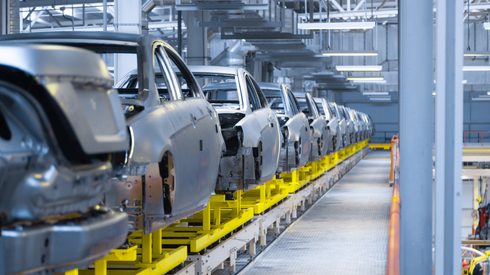Total monthly sales of electric vehicles (EVs) in China reached 1.026 million units in November, with Singles Day in early November, local subsidies and automakers’ efforts to increase sales at year-end contributing to soaring volumes, according to China Association of Automobile Manufacturers (CAAM).
Of the total, plug-in electric vehicle (PEV) sales increased by 13.5% year on year to 702,000 units, and plug-in hybrid sales spiked by 89.5% from a year earlier to 323,000 units.
Over January-November, China produced 8.43 million EVs, up by 34.5% on a yearly basis, while total sales increased by 36.7% to 8.3 million units over the same period.
In the first 11 months of 2023, production of PEVs totaled 5.89 million units, up by 21.1% year on year, while output for plug-in hybrids rose by 81.4% to 2.53 million units. Within the same period, sales of PEVs reached 5.86 million units, up by 23.6% and plug-in hybrids increased by 83.5% to 2.44 million units.
Bearishness prevails in battery raw materials markets
China’s lithium prices remained mostly on a downtrend over the past month amid weak consumer demand, while buying appetite was further curtailed by year-end when consumers typically minimize purchases.
“Consumers have been only honoring their long-term deliveries of lithium salts. There is barely any spot demand for lithium salts,” a Chinese lithium producer source said.
Market participants noted that lithium consumers avoided holding excess inventories in the year-end season for better financial performance in their annual reports.
Market sentiment has also remained bearish, with participants expecting the current weakness in lithium demand and prices to persist into the first quarter.
Fastmarkets’ weekly price assessment of lithium carbonate 99.5% Li2CO3 min, battery grade, spot price range exw domestic China was 95,000-105,000 yuan ($13,364-14,771) per tonne on Thursday December 14, up by 5,000 yuan per tonne from 90,000-100,000 yuan per tonne a week earlier, but down by 60,000-63,000 yuan per tonne from 158,000-165,000 yuan per tonne on November 2.
Fastmarkets’ weekly price assessment of lithium hydroxide monohydrate LiOH.H2O 56.5% LiOH min, battery grade, spot price range exw domestic China was 90,000-100,000 yuan per tonne on Thursday down by 10,000 yuan per tonne from 100,000-110,000 yuan per tonne a week earlier, and down by 55,000-60,000 yuan per tonne from 145,000-160,000 yuan per tonne on November 2
Prices for another battery raw material, cobalt sulfate, continued a downward trend in November and into December due to weak downstream buying and bearish market sentiment.
Fastmarkets’ price assessment for cobalt sulfate, 20.5% Co basis, exw China was 30,000-32,000 yuan per tonne on December 15, unchanged from December 13, but down by 7,000-8,000 yuan per tonne from 38,000-39,000 yuan per tonne on November 1.
“The overall market sentiment has kept bearish due to oversupply expectations and thin buying appetite from the downstream sector. I think the sluggish situation will last till the first quarter of 2024,” a cobalt sulfate producer said.
“Downstream buyers have slowed down their purchases for cobalt sulfate since November. Moreover, increasingly cheaper material produced from mixed hydroxide precipitate (MHP) put pressure on prices,” a second cobalt sulfate producer said.
According to sources, the increasing number of mixed hydroxide precipitate (MHP) projects in Indonesia were expected to put further pressure on an already sluggish cobalt market by adding to existing oversupply.
Graphite, both synthetic and natural graphite, the major raw materials for lithium ion battery anodes, has been experiencing similar trends to the above cathode raw materials.
Fastmarkets assessed the price for green petroleum coke 0.5% S, ex-works China at 2,000-2,900 yuan per tonne on December 20, down by 18.33% from the start of November.
On the same day, the price for petroleum needle coke 0.5% S, ex-works China was assessed at 4,700-5,000 per tonne, down by 5.83% from the start of November.
“The price for anodes continues to drop with battery makers bidding prices lower. For green petroleum coke, slow demand from both the aluminium and anodes sectors are pressuring the market. For needle coke, it is more difficult due to anode producers’ efforts to cut costs, trying to use cheaper green petroleum coke as an alternative,” a needle coke producer said.
The natural graphite market has also been under pressure, albeit with less downward movement than for the corresponding synthetic graphite. This is because China imposed export controls on graphite in the end of October, which triggered increasing buying in November.
Fastmarkets’ weekly assessment for graphite flake 94% C, -100 mesh, fob China was at $540-570 per tonne on December 14, down by 0.45% week on week but widening from $530-575 per tonne on November 2.
“The market direction for the natural flake graphite could be uncertain if we factor in the export control. As far as I know, not many exporters have got approval from China’s Ministry of Commerce [to export]. This might take longer than people had expected,” a graphite producer said.
“But the overcapacity in synthetic graphite, as well as slow demand from the anode sector, will continue to weigh on the flake graphite market,” the producer source added.
Download our ebook ‘Mastering the EV revolution’
Our ebook ‘Mastering the EV revolution’, provides a state of the market by exploring four key, real-life scenarios and how Fastmarkets can offer practical, intelligible solutions. Download now.






